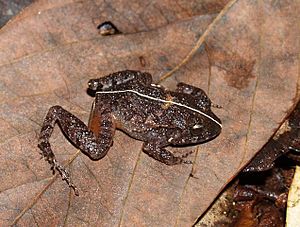Craugastor polyptychus facts for kids
Quick facts for kids Craugastor polyptychus |
|
|---|---|
 |
|
| Conservation status | |
| Scientific classification |
The Craugastor polyptychus is a fascinating type of frog from the family Craugastoridae. These small amphibians are found in the warm, wet areas of Central America. You can discover them hopping around in countries like Costa Rica, Nicaragua, and Panama.
This frog loves places that are moist and green. Its natural habitat includes tropical lowland forests, especially those with lots of moisture. They can also be found in plantations, which are large farms, and even in people's rural gardens. Sometimes, they live in areas that used to be forests but have changed a lot.
Contents
Meet the Craugastor Polyptychus Frog
The Craugastor polyptychus is a unique frog species. It was first described by a scientist named Edward Drinker Cope in 1885. This means he was the first person to officially give it a scientific name and study it. Frogs like this one are an important part of their ecosystem. They help control insect populations and are a food source for other animals.
Where Does This Frog Live?
This frog lives in specific parts of Central America. It prefers warm, humid climates.
- Costa Rica: A country known for its rich biodiversity and rainforests.
- Nicaragua: The largest country in Central America, with many lakes and volcanoes.
- Panama: Famous for the Panama Canal, it also has vast areas of tropical forests.
These frogs need a lot of moisture to survive. They thrive in places where there is plenty of rain and humidity. This is why they are often found in lowland forests, which are close to sea level and usually very wet.
What Threats Does This Frog Face?
Sadly, the Craugastor polyptychus frog is facing challenges. The biggest threat to its survival is habitat loss. This happens when the places where these frogs live are destroyed or changed.
- Deforestation: Forests are cut down for farming, building, or other human activities. This removes the trees and plants the frogs need for shelter and food.
- Development: New roads, towns, and buildings can take over the frog's natural areas.
- Pollution: Chemicals from farms or industries can harm the water and soil, making it unsafe for frogs.
When their homes disappear, these frogs have nowhere to go. This makes it harder for them to find food, water, and safe places to lay their eggs. Scientists and conservationists are working to protect these important habitats.
See also
 In Spanish: Craugastor polyptychus para niños
In Spanish: Craugastor polyptychus para niños


